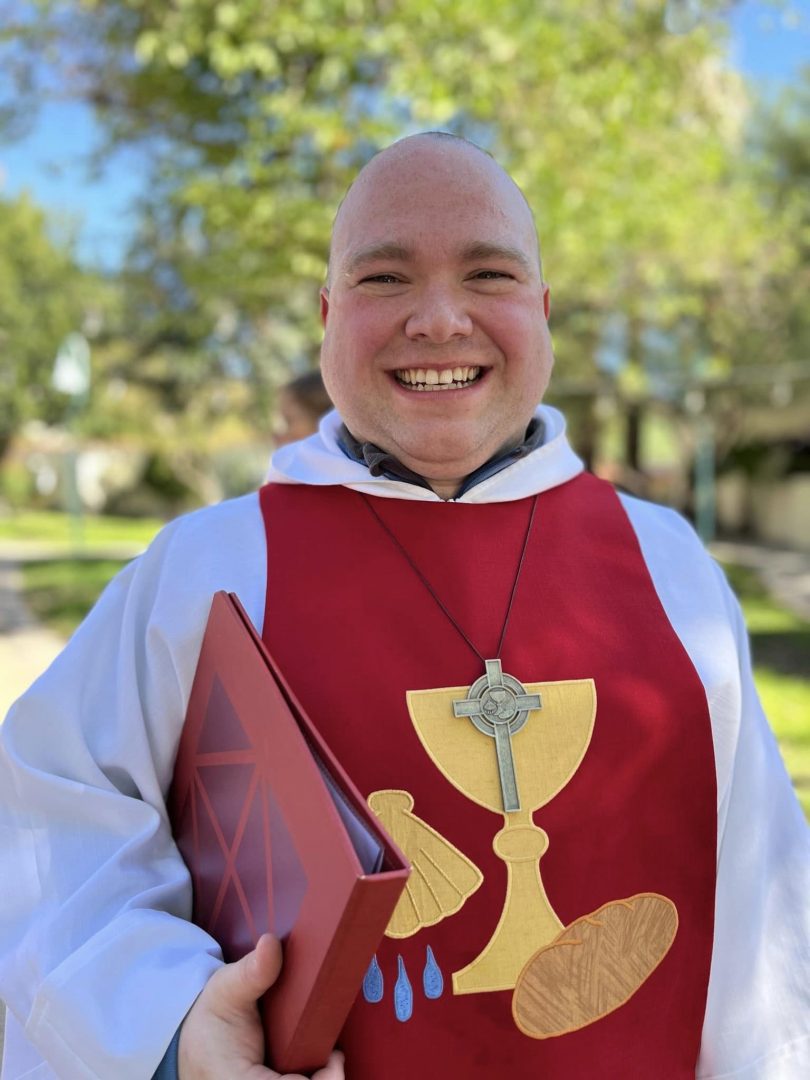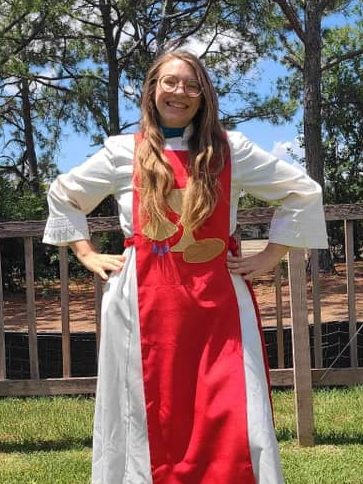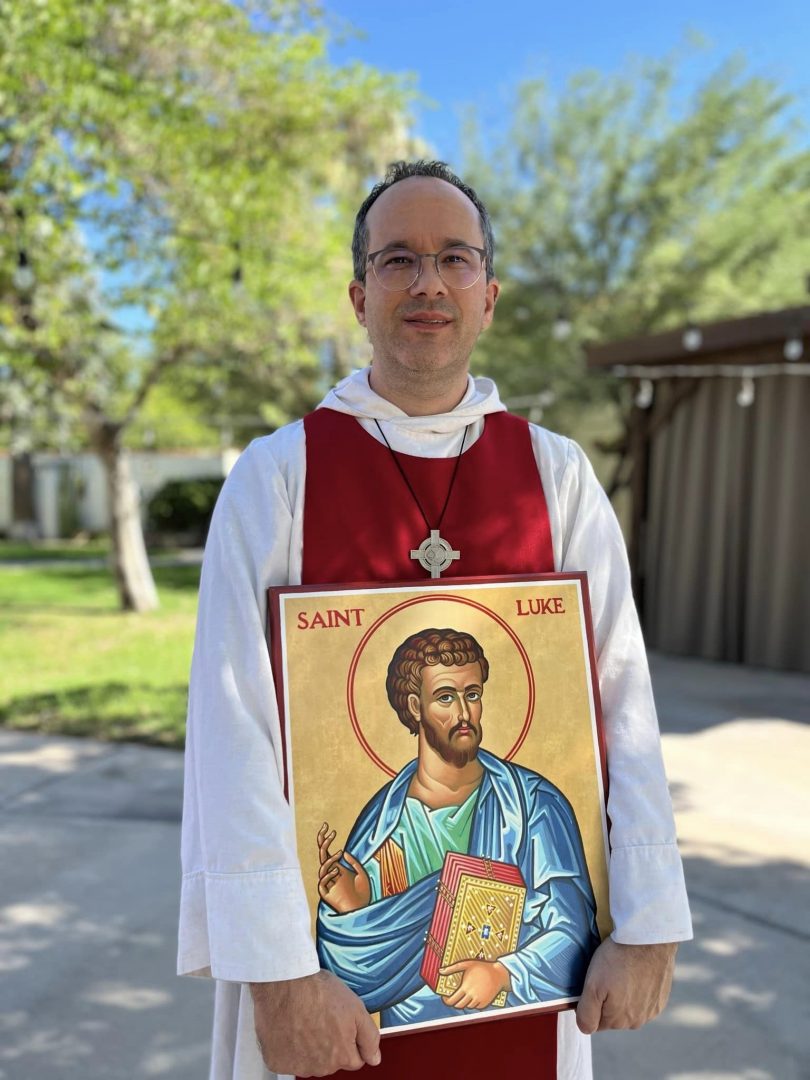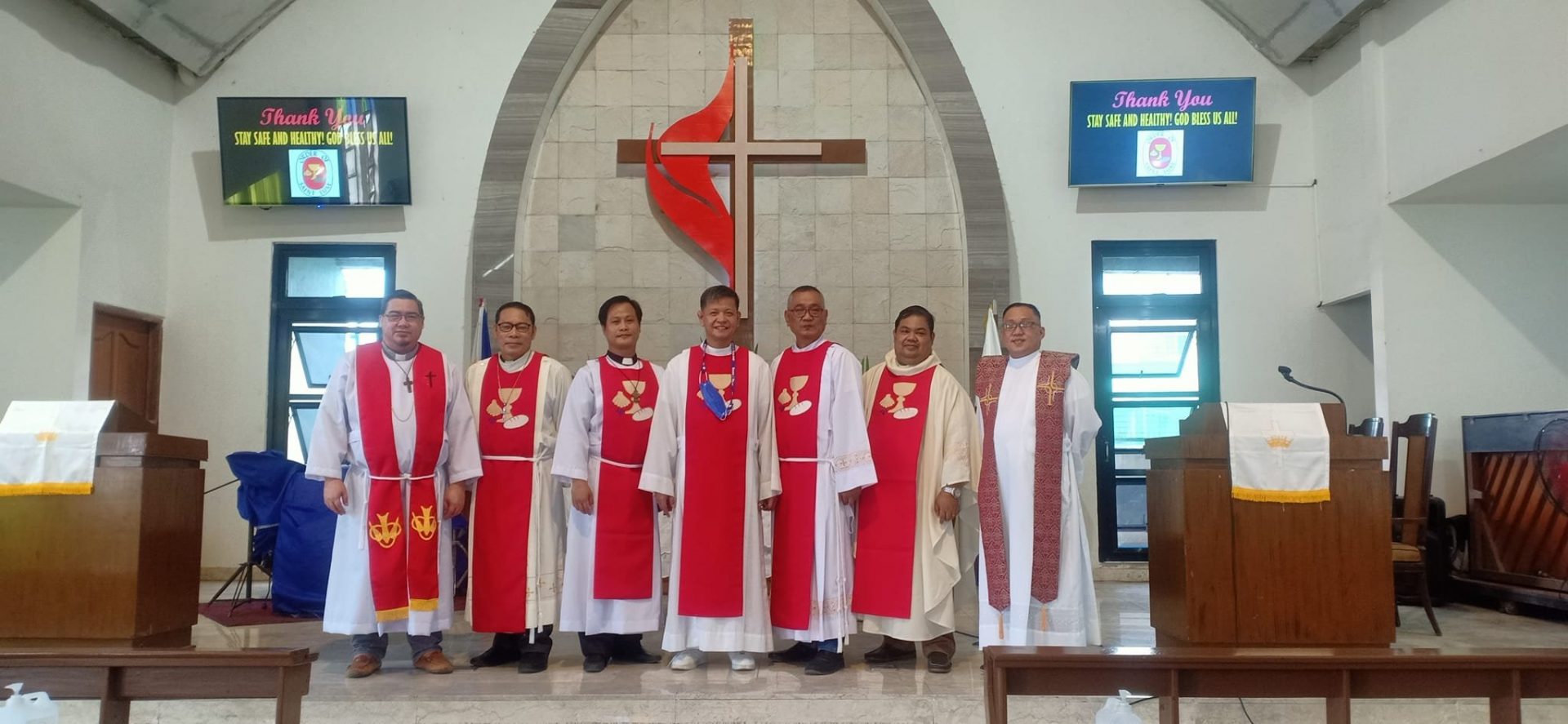The habit of the Order of Saint Luke® is an alb (a baptismal garment uniting the person with the whole of the baptized community), a red cincture (symbolic of the vows into which the member of the Order is seeking to live with the help of the Holy Spirit), and a red scapular with symbols from the seal of the Order (a servant apron symbolizing the member’s service in the Order, the Church, and the world).
The official habit of the order is worn by laity and clergy and is identical. The habit consists of:
- a white alb of unspecified style
- a red rope cincture knotted on the left side (optional)
- a red scapular with the OSL logo as depicted at left
- an OSL patch attached to the left sleeve of the alb (optional)
As a symbol of equality within the Order, we do not wear symbols of rank, or symbols distinguishing ordination status (nor do we use titles other than those indicating a specific office within the Order.)
Only the Celebrant at a particular Eucharist wears a stole and/or chasuble at OSL events. Everyone else wears the common habit (the exception being the General Officers, who wear scapulars embroidered with a symbol of their office in addition to the OSL logo.)

The wearing of the OSL habit is entirely voluntary. If members choose not to wear it, they are still requested to refrain from wearing a stole unless presiding at Eucharist. The scapular color does not change with the liturgical seasons, but remains red, even when worn by members participating as worship leaders or assistants, because it is a vestment of the order rather than a liturgical vestment.
Pectoral crosses are worn by some, but not all, many choosing to wear the OSL logo cross.
The OFFICIAL scapular of The Order of Saint Luke is manufactured by Gaspard, Inc.
Gaspard, Inc.
200 N. Janacek Rd.
Brookfield, WI 53045
phone: 800-784-6868
Ask for Part Number: OSLSCAP (“Order of Saint Luke® Scapular in Red Adventura Fabric”)
Please note: this item is a custom order and IS NOT AVAILABLE on the Gaspard, Inc. website. Telephone orders only.
The Story Behind the Habit of the Order of Saint Luke: A Memoire
Br. Dwight W. Vogel, OSL
It will come as no surprise to my sisters and brothers in the Order that significant events in my life demand significant rituals to mark them. My use of the word “significant” is important and intentional. That is, both the event itself and the ritual that accompanies it need to involve symbolic signs.(1) They need to be sign-ificant. My election as abbot of the Order is one of the most significant events in my life and the ritual event to mark it needed to put it in company with my ordination and my wedding.(2)
There was a service of investiture in The Book of Offices and Services of the Order of Saint Luke in use at the time. That would provide the template. The prevailing practice, then as now, is that newly elected abbots design the service to reflect their own perspective on the event. I would need to put the investiture within the larger context of a full service. While the investiture service provided significant language, its use of visual symbolic signs was quite anemic, in fact non-existent! There was no vesting to be done in the service of investiture.
What should I wear? Certainly an alb, for basic to the calling of an abbot is the baptismal covenant shared with all Christians and the alb should be (although we seldom recognize it) reminiscent of a baptismal garment. No, I just realized I don’t mean that!! The alb IS a baptismal garment. When I put on my alb, I am putting on my identity as being part of the baptized community throughout Christian history and around the world. Our Lukan vow of “living for the Church of Jesus Christ” refers to this basic understanding of our identity with the larger community of faith, the universal Church. The Order of Saint Luke is not an end in itself. It emerges from the Church. It lives out its apostolate in service to the Church and the world. The alb (whether white or from natural fibers) was a fitting place to start.
Then I had to consider the appropriate liturgical color for an Order whose patron is Saint Luke. The color designated for the Feast of Saint Luke is red, for the tradition is that Saint Luke was martyred. The rope that fastens around the waist is called a cincture (from the Latin “to encircle”). Rather than being a neutral color, the cincture could be red. The ideas (or inspirations which seems a more appropriate word for my experience) started to come thick and fast. When I tied the knot in my cincture, I could remind myself of the vows by which I bound myself to the Rule of Life and Service of the Order. Since red is also the color for Pentecost, it could be a symbolic sign of the presence of the Holy Spirit. So when I tied the red cincture I would be praying: “Holy Spirit, help me live into the vows I have taken.”(3)
What liturgical vestment could be put over the white alb and red cincture in an sign-act of investiture? I remembered the black scapulars of the Benedictines at St. John’s Abbey in Collegeville, MN, where Linda and I lived during two sabbaticals. I remembered that the scapular was understood as a servant’s apron and would carry with it the recognition that I was to be in servant ministry. It should not be black, then, but red, with polysymbolic reference both to Saint Luke as a martyr (literally, a witness) to the good news of Jesus Christ, as well as an ongoing invocation of the presence and direction of the Holy Spirit to which Luke’s writings point.

To make the connection with The Order of Saint Luke explicit, have the emblem of chalice, paten, and baptismal shell from the seal of the Order on both front and back. Then I realized that what I had started out envisioning as a vestment for the abbot could really to apply to all the general officers. All this invoking of the Holy Spirit really began to open me up to a much more important recognition: this is not a vestment for the abbot; this is a habit (the characteristic attire of members of a religious order) for all members of The Order of Saint Luke. The Spirit with prevenient grace had already guided me to the scapular which is not gender specific, nor does it make any distinction between lay and clergy. It could be the Lukan habit, appropriate for any and all members of the Order.
Having had my mind blown open to do work that was much more widely significant than I had first intended, I then had to consider if there was something specific to my role as abbot which should be added. The crozier (shepherd’s staff) was a dominant symbolic sign of the role of abbot as shepherd. At that point, a pastoral concern emerged. I wanted this to be something that would meet the needs of the Order for richer symbolic expression. A crozier, the Spirit seemed to be telling me, would be too much too soon.(4) However, perhaps the crozier with the white banner that is a sign of the abbot could be portrayed simply on the scapular. Put it, and the symbols denoting the other general officers, on the back only. There it could be seen as we knelt for the investiture and in procession, the community could see it design. However, when facing the community, our habit would look just like all the others. Thus, I sought to balance communal identity and servant roles.
One other symbolic sign related to my investment as abbot emerged. The chair in which an abbot (or a bishop) is seated is a “cathedra.” Certainly the throne-like cathedra’s of some abbeys and cathedrals was not appropriate for two reasons: one, the implicit attention to power and authority (the etymology inf both Latin and Greek is simply “seat”), and second, we are a dispersed order; we have no one cathedra-l or abbey. Our cathedra needed to be both simple and portable. I talked with Br. Bill and Sr. Mable Doser, renowned liturgical fabric artists, who designed a simple cathedra which could be hung over any chair or pew anywhere the Order gathered. They chose to base it on the ox representing Luke the Evangelist in the book of Kells and an abbot’s crozier or shepherd’s staff. It was first used at my investiture. Abbot Michael O’Donnell was seated in an ordinary chair with the cathedra over the back. When I returned to take my seat after a literal investiture, it was to the chair with the cathedra. The cathedra has stood the test of time in all subsequent abbatial investitures and whenever the Order gathers in the abbot’s presence.(5) I like the practice which has emerged of taking the cathedra from the chapel and hanging on the back of the abbot’s chair when we meet for business or learning.
When we announced the availability of the scapular to members of the Order, I was amazed at the response. Suddenly, at the investiture of the new officers in 1996, they were everywhere. I have been delighted to see them taken to heart by so many members of the Order.
As is often the case with liturgical practices within the order, when they are worn varies widely. The first thing that needs to be said is that wearing the habit is optional and not mandatory. One’s membership in the Order does not reside in whether one wears the habit or not. However, for me, they are symbolic signs of having taken vows in the Order of Saint Luke. They will serve their function best if wearing the habit is left until one has taken first vows. Being invested with the scapular at that time can be a deeply meaningful act.
Rather than tell you when I think you should wear your habit, I will tell you when I do: Always as a member of the community at Services of Word and Table, Services of Profession, and Services of Investiture (unless I’m catching a plane right afterwards and don’t want to have to open a suitcase again!) I usually wear it at chapter and subchapter services when I have leadership responsibilities.(6) At retreat, I wear it almost always for Evening Prayer. At Morning Prayer, it depends on how much of a rush I’m in (I’d rather get there on time than be late because I’m putting on my habit). I do not wear it for the diurnal offices which by design are to be prayed in the everyday setting in which we find ourselves, though I have no problem with others wearing the habit when they lead us in those hours. I’ve found through the years that increasingly I want to wear it for Compline when on retreat. There’s something deeply satisfying about my wearing it with my brothers and sisters in that quiet, simple setting.

What does it mean for me to wear our habit? It is a symbolic sign that I have taken upon myself the Rule of Life and Service of the Order, and that the Holy Spirit sustains and guides me as I live into those vows. It is a symbolic sign to my brothers and sisters in the Order that we are bound together in a community; together we are members of the Lukan family. It can be a witness to those outside the Order that there is such a group which is part of my Christian identity.
Thus, the habit of the Order of Saint Luke is an alb (a baptismal garment uniting me with the whole of the baptized community), a red cincture (symbolic of the vows into which I am seeking to live with the help of the Holy Spirit),(7) and a red scapular (the servant apron symbolizing my answer to service in the Order, the Church, and the world). And that’s the story of how it came to be.
(1) It depends upon which scholar is writing as to whether sign or symbol is the most appropriate word. One might say that signs point to something beyond themselves; symbols participate in that to which they point. However, the word “signs” is often used by liturgical scholars in a “strong” sense akin to “symbols” in the distinction I just made. There must be a doctoral dissertation or two on all this, but my writing about how the OSL habit came to be isn’t the place to do it. In other words, I am not going to “chase this rabbit” down the garden path of turning this into a scholarly article rather than a memoire, tempting though that may be. The point is I want to imply the “strong sense” of the words I’ve chosen.
(2) My joining the Order of Saint Luke in 1986 was done by mail; there was no ritual event. Taking life vows in the Order should probably be there, but in my own autobiography that happened at the same event as my investiture as abbot.
(3) When we developed the opportunity to take life vows, the simple act of tying an additional knot on the cincture carries the same bimodal symbolism: binding myself to my vows. guided and sustained by the Holy Spirit.
(4) As members of the Order know, this did eventually come to pass. And here I want to leave a historical footnote about the role that Br. Matthias Tanner and I played, purposely off-stage. Together we developed and funded the design for pectoral crosses for the Order (not just for the abbot as in prevailing monastic practice) and in due time, a crozier for the abbot.
(5) When the abbot cannot be present at an event which is usually shepherded by the abbot, the presence of the cathedra on the back of an empty chair may be a moving reminder of the abbot’s role.
(6) Yes, even when presiding at Table. It is not a eucharistic vestment (a chasuble is an optional vestment for that) or a vestment for the role of the elder in Services of the Word (stoles are appropriate for that as well as, in Methodist practice, for presiding at the table). It is simply a symbolic sign of identity with the Order.
(7) I choose to always use the red cincture in all liturgical seasons, symbolizing my identity as living out my ministry in the context of my Lukan vows and the Holy Spirit’s aid in my living into them.
